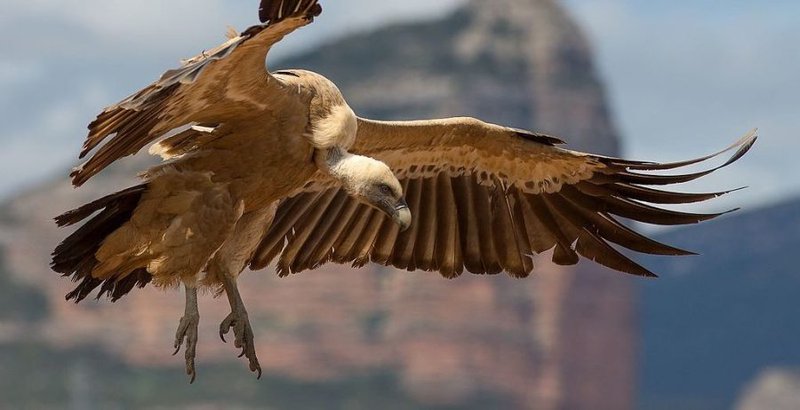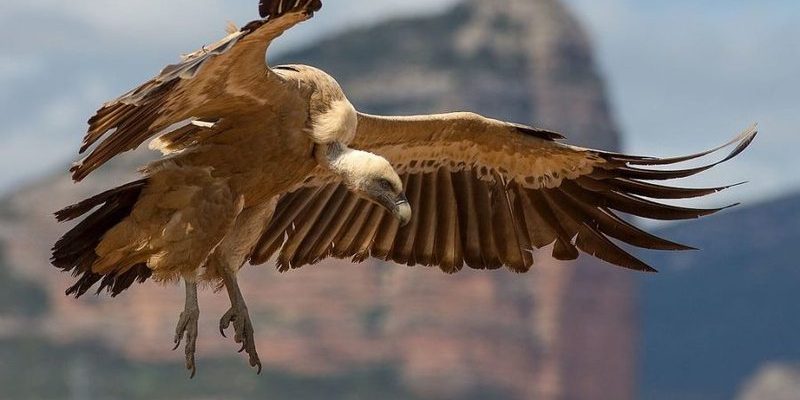
Physical Characteristics of the Griffon Vulture
To identify a Griffon Vulture, it’s crucial to first recognize its unique physical traits. These birds are not just large; they are impressive. Adult Griffon Vultures can have a wingspan of up to 2.8 meters (about 9 feet), making them one of the largest birds in Europe. Picture yourself standing next to a door; that’s how wide their wings can spread!
Their bodies are covered with a mix of brown and white feathers, which can appear somewhat scruffy due to their lifestyle. The most noticeable feature is the naked, pale head and neck. This lack of feathers helps them stay clean while feeding on carrion, which is a bit gruesome but very practical for a scavenger. If you spot a large bird with a bulky body and a bare neck, you might just be looking at a Griffon Vulture.
Moreover, Griffon Vultures have a powerful beak, adapted for tearing into tough hides. This is a key identifying feature. Their beaks are hooked at the end, resembling a strong, curved tool. This not only allows them to feed on carrion but also makes them formidable in their role as nature’s clean-up crew.
Coloration and Patterns
Let’s talk a little more about coloration. Adult Griffon Vultures are predominantly light brown with subtle variations. Juveniles, on the other hand, have darker plumage and don’t develop their adult coloring until they’re around 5 years old. So, if you spot a smaller, darker vulture, it might still be a young Griffon!
It’s also interesting to note that these birds have white patches on their shoulders, which can sometimes help you identify them from a distance. Once you start looking for these features, you’ll find it easier to pick them out from other birds soaring overhead.
Behavior Patterns of Griffon Vultures
Behavior is a significant clue when identifying these vultures. Griffon Vultures are social creatures and often fly in groups—sometimes even dozens at a time. Watching them circle high in the sky can be mesmerizing. They use thermals (rising warm air) to stay aloft with minimal effort, and their gliding pattern is quite distinctive. If you see a large bird gliding and soaring in circles, it’s likely not an eagle, but a Griffon Vulture.
Another behavior to watch for is their feeding method. These vultures are predominantly scavengers, relying on their keen eyesight to spot carrion from great heights. When they find food, they often gather in large numbers, which can create quite a spectacle.
If you’re hiking and come across a group of vultures, you could be witnessing their feeding frenzy. Make sure to watch from a distance; they can be protective of their meal!
Vocalizations
Often overlooked, the sounds made by Griffon Vultures can aid in identification too. Unlike many birds, these vultures don’t have a melodious song. Their vocalizations are more about grunting and hissing. It’s not the kind of call that draws you in, but rather a way for them to communicate with one another, especially in their social groups. If you hear strange, hissing sounds coming from a flock of large birds, it’s worth looking closer to see if they’re Griffon Vultures.
Habitat and Range
Understanding where Griffon Vultures live can significantly improve your chances of spotting them. These birds prefer rugged terrain, often found in mountainous regions or areas with *open grasslands*. They can be seen across parts of Southern Europe, North Africa, and even some parts of Asia.
When you’re exploring potential habitats, keep an eye out for rocky cliffs or steep hillsides. Griffon Vultures often nest in these hard-to-reach places, making it easier for them to take flight. If you find yourself hiking in areas like the Pyrenees or the Alps, you might just get lucky!
Another great tip? Early mornings or late afternoons are often the best times to see them taking flight. The lighting can be beautiful, and the vultures are more active as they search for food.
Conservation Status
It’s important to acknowledge the conservation status of Griffon Vultures. Over the years, their populations have faced significant threats due to habitat loss and poisoning from consuming contaminated carrion. Thankfully, many countries have recognized the importance of these scavengers and have implemented various conservation efforts.
Spotting a Griffon Vulture is not just about enjoying their beauty; it’s also about understanding their role in the ecosystem. They keep our environment clean, and their decline could have serious impacts. If you see one, remember you’re witnessing a species that has adapted well to its environment, yet still faces challenges.
Tools for Birdwatching
When you’re on the lookout for Griffon Vultures, having the right tools can make all the difference. A good pair of binoculars is essential. Look for ones with at least 8x magnification; that way, you can see the details of their feathers and behavior from a distance without disturbing them.
If you’re planning a serious birdwatching trip, consider bringing a bird guidebook or downloading a bird identification app on your phone. These resources not only help you identify vultures but also other species you might encounter along the way.
Equipping yourself with knowledge about their habitats, behaviors, and characteristics will enrich your experience in the wild.
Dress and Prepare for Observation
Dressing appropriately for your birdwatching adventure is just as vital. Wear comfortable shoes, and dress in layers; the weather can change quickly in areas where vultures are found. Bring enough water and snacks, and try to keep noise to a minimum. This will help you stay focused and increase your chances of seeing these majestic birds in their natural element.
Final Thoughts
Identifying a Griffon Vulture in the wild can be one of those unforgettable moments for nature lovers. With their impressive wingspan, unique features, and critical role in the ecosystem, they’re truly remarkable birds. Remember, it’s not just about spotting them; it’s also about understanding and appreciating their place in nature.
So next time you’re out on a trail, keep an eye on the sky. You just might catch a glimpse of these magnificent vultures soaring overhead, adding a bit of magic to your outdoor experience. Happy birdwatching!

